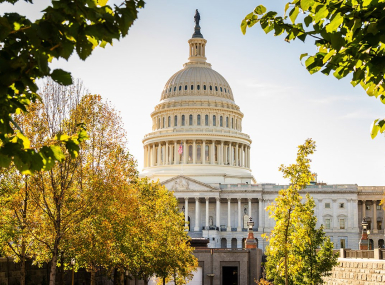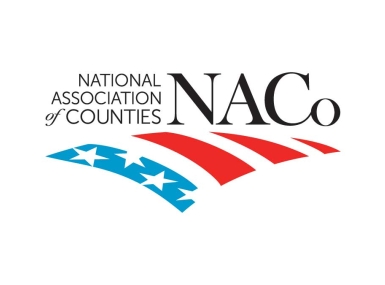Legislative Analysis for Counties: The Fiscal Responsibility Act of 2023

Upcoming Events
Related News
After several rounds of negotiations, the White House and House Republican Leadership reached an agreement to address the debt limit and cap spending. The deal, titled the Fiscal Responsibility Act of 2023 (FRA) (H.R. 3746), would suspend the debt ceiling through January 1, 2025, effectively increasing the amount of money that the federal government can borrow to fund federal programs. On January 19, 2023, the U.S. Department of the Treasury announced that the federal government had hit its $34.1 trillion debt limit. This agreement comes less than a week ahead of the deadline after which the federal government would no longer have the capacity to pay its obligations.
After quickly passing the House, the legislation passed the Senate by a vote of 63-36 on June 1, ensuring the federal government will not run out of money to pay its bills on Monday, June 5, the day the government would default on its debt.
The nonpartisan Congressional Budget Office (CBO) released its assessment of the bill’s impact on federal debt and deficits. CBO estimated that if the legislation were enacted, budget deficits would be reduced by about $1.5 trillion over the next decade and interest on the public debt would be reduced by an estimated $188 billion.
NACo applauds our federal partners for reaching a bipartisan agreement to raise the federal debt ceiling. While this is a significant move that will provide much-needed certainty to counties, there are a handful of provisions of relevance to local leaders including spending cuts, permitting reform, implementing new work requirements for certain federal public assistance programs and reinstating federal student loan payments.
A comprehensive analysis of the Fiscal Responsibility Act and its impact on county governments is below.
Key County Highlights of the Debt Proposal
- DOES NOT rescind State and Local Fiscal Recovery Fund (SLFRF) dollars, including the $65.1 billion provided directly to counties, or Local Assistance and Tribal Consistency (LATCF) dollars
- Caps non-defense discretionary spending for Fiscal Year (FY) 2024 at roughly $704 billion, followed by a 1 percent increase in discretionary spending in FY 2025
- Includes new administrative requirements and eligibility restrictions while also expanding exemptions for homeless individuals, veterans and youth aging out of foster care to federal food assistance and cash benefit programs
- Reforms the permitting process for federally funded infrastructure projects, including shortened review timelines and limited page numbers for environmental review documents
- Clawbacks for unobligated federal funding appropriated in response to the COVID-19 pandemic
- Cuts to the Internal Revenue Service (IRS) budget increases enacted in the Inflation Reduction Act (IRA)
- Reinstates federal student loan payments on defaulted loans by August 29, 2023.
Overview Of Provisions
Rescissions
County PriorityThe American Rescue Plan Act’s State and Local Fiscal Recovery Fund (SLFRF) and Local Assistance and Tribal Consistency Fund (LATCF), which are both administered by the U.S. Department of Treasury, are not affected by this legislation. Counties can continue to invest SLFRF and LATCF funds to strengthen their communities. |
The Fiscal Responsibility Act would rescind approximately $28 billion in unobligated COVID-19 funding, including funds made available through the American Rescue Plan Act (ARPA), Coronavirus Aid, Relief and Economic Security (CARES) Act, and other pandemic-related spending bills. Of particular note to counties, no SLFRF dollars, including the $65.1 billion provided directly to counties, will be rescinded. Additionally, no LATCF dollars will be rescinded.
Other federal investments important to counties that are safe from rescission include unobligated amounts from:
- Advance appropriations in Division J of the Infrastructure Investment and Jobs Act/Bipartisan Infrastructure Law (P.L. 117-58)
- Appropriations in Division B of the Bipartisan Safer Communities Act (P.L. 117-59), including for local law enforcement
- Appropriations for the Tenant-Based Rental Assistance Program (P.L. 117-103)
- Emergency appropriations for COVID public mass transit assistance
- Appropriations for the Hazardous Substance Superfund in the FY 2023 omnibus (P.L. 117-328)
- Clean energy tax credits authorized under the Inflation Reduction Act (P.L. 117-169)
For your reference, a full list of proposed recissions is available here.
Permitting Reform
County PriorityThe FRA addresses longstanding county priorities around permit streamlining for all infrastructure projects through proposed commonsense reforms to the National Environmental Policy Act (NEPA). |
The FRA includes the majority of Rep. Garrett Graves’ (R-La.) legislation, H.R. 1577, the Building United States Infrastructure through Limited Delays and Efficient Reviews (BUILDER) Act, into the agreement.
BUILDER would codify much of the “One Federal Decision” 2017 Executive Order including the NACo-supported provisions below, that were previously repealed by the Biden administration:
- Limit the timeline for agency reviews to two years whenever possible
- Limit the number of pages for environmental impact statements and environmental assessments
- Establish a lead agency for review
- Establish a process for local governments to be appointed as a joint lead agency, thereby enabling us to participate in the schedule planning process for NEPA analyses
- Create procedures to elevate delays or disputes
- Require the preparation of a single environmental impact statement
Not all the provisions of the BUILDER Act are included in the bipartisan agreement, such as those that would have required a federal agency to pay $100 per day to applicants whose review deadlines are unmet, and that would have limited judicial review to individuals meaningfully involved in the public comment period required by NEPA for covered infrastructure projects.
In addition to the BUILDER language, additional permitting provisions in the legislation would:
- Establish that a federal agency can adopt another agency’s categorical exclusion
- Designate that an environmental document can be up to five years old as long as there are no new substantial circumstances that would impact the analysis
- Expedite completion of the Mountain Valley Pipeline, an under-construction natural gas pipeline running from West Virginia to Virginia
- Require the Council on Environmental Quality to study the potential for “online and digital technologies to address delays in reviews and improve public accessibility and transparency” and submit a corresponding report to Congress on “E-NEPA” within one year of enactment
New Administrative Requirements and Eligibility Restrictions For Public Assistance Programs
The FRA includes policy changes to both the Supplemental Nutrition Assistance Program (SNAP), which provides grocery benefits to low-income households, as well as the Temporary Assistance for Needy Families (TANF) program, which offers flexible funding to states for anti-poverty programs serving families with children, including direct cash assistance. Counties administer both programs in California, Colorado, Minnesota, New Jersey, New York, North Carolina, North Dakota, Ohio, Virginia and administer SNAP in Wisconsin, meaning counties in these states will be responsible for implementing these changes and performing outreach to impacted participants in these states.
Changes to TANF
Under current law, in order to receive the full federal block grant, a state must ensure that an adult recipient in at least 50 percent of single-parent families and 90 percent of two-parent families are engaged in a work-related activity. For states that have reduced their TANF caseloads since 2005, these percentages are lower. The FRA would limit these flexibilities by recalibrating the caseload reduction credit to 2015 caseload levels (rather than the 2005 caseload levels).
The FRA would also allow up to five states to establish six-year pilot programs replacing their current work participation rate targets, requirements and penalties with alternative “work and family outcomes” benchmarks negotiated with the U.S. Department of Health and Human Services (HHS). Meanwhile, beginning in FY 2025, HHS must collect state data on a new set of work outcomes metrics, aligned with the Workforce Innovation and Opportunity Act (WIOA) for TANF recipients.
NACo continues to call for a bipartisan, substantive reauthorization of the TANF program to align the program with the broader workforce and human services systems that support economic well-being and mobility.
Changes to SNAP
Along with meeting income eligibility requirements, SNAP participants must also fulfill general work requirements unless they fall into an exempt category. Under current law, able bodied adults without dependents (ABAWDs)—individuals under 50 who are deemed work-eligible and not living with children—cannot receive SNAP benefits for more than three months within a 36-month period unless they participate in a work or attend a training program for at least 20 hours per week. States are allowed to annually exempt up to 12 percent of ABAWDs not otherwise exempt from the SNAP time limit, including by carrying over unused exemptions from year to year, and may also apply for regional or state-wide waivers in times of economic downturn.
The FRA expands the ABAWD time limit to include individuals up to age 54, phasing the age-limit increase in by FY 2025 and keeping it in place until FY 2030. The FRA exempts homeless individuals, veterans, and youth aging out of foster care from the ABAWD time limit during this same period.
The FRA also permanently reduces allowable state ABAWD exemptions from 12 to 8 percent and ends state flexibility to carry over ABAWD exemptions from year to year, while also mandating the U.S. Department of Agriculture to publish all state ABAWD waiver requests and the agency’s response.
NACo supports greater flexibility for states and counties in designing and implementing the SNAP program according to their needs and economic context, including the discretion to waive ABAWD requirements and streamline application and eligibility processes to reduce administrative burden.
Budget Caps
As part of the bipartisan agreement, the Fiscal Responsibility Act would establish discretionary budget caps for FYs 2024 and 2025 and includes spending limits for both defense and nondefense discretionary spending for both fiscal years.
For FY 2024, the bill would cap topline discretionary spending at $1.58 trillion or approximately 6.7 percent less than the comparable FY 2023 topline spending level. For FY 2024, defense spending would be limited to $886.3 billion, approximately 3 percent or $28 billion more than the comparable FY 2023 level, and non-defense spending would be limited to $703.6 billion, approximately 9 percent or $70 billion less than the comparable FY 2023 level. For FY 2025, the bill would allow for 1 percent growth over the prescribed FY 2024 spending levels, capping topline discretionary spending at $1.606 trillion and limiting defense spending to $895.2 billion and non-defense spending to $710.7 billion.
|
Spending Type
|
FY 2024 (in B)
|
FY 2025 (in B)
|
|---|---|---|
|
Defense |
$886.3 |
$895.2 |
|
Non-Defense |
$703.7 |
$710.7 |
|
Total |
$1,508 |
$1,605.9 |
To incentivize timely enactment of federal spending bills, discretionary spending levels would be reduced 1 percent below current FY 2023 levels if FY 2024 and 2025 bills are not enacted by January 1 of the respective fiscal year. Furthermore, the topline spending caps for both FY 2024 and 2025 would be enforced through sequestration in which automatic spending cuts are triggered if these spending limits are exceeded. However, the bill allows for adjustments to account for spending related to disaster relief by reinstating the disaster funding cap adjustment formula that was in place from FYs 2012-2021 under the authority of the Budget Control Act of 2011 (BCA). This formula allows for adjustments to discretionary spending caps to account for disaster relief spending by 5 percent of the total appropriations for major disasters as designated by the Stafford Act.
If enacted, the bill would also allow for adjustments based on spending related to disability reviews and redeterminations, controlling health care fraud and abuse, and making grants to states for Social Security reemployment services and eligibility assessment. However, the amount of these adjustments would be statutorily capped for both FYs 2024 and 2025.
Additionally, the bill would prescribe non-enforceable topline spending goals for FYs 2026 through 2029, allowing for 1 percent annual growth each fiscal year and adjusting for U.S. Department of Veterans Affairs health spending. For FYs 2026-2029, the Fiscal Responsibility Act does not specify defense and non-defense spending limits and the topline amounts set by the bill are as follows:
|
Fiscal Year
|
Total (in billions)
|
|---|---|
|
FY 2026 |
$1,621.9 |
|
FY 2027 |
$1,638.2 |
|
FY 2028 |
$1,654.6 |
|
FY 2029 |
$1,671.1 |
The agreement provides $20.3 billion in FY 2024 and $24.5 billion in FY 2025 outside of the discretionary caps for the U.S. Department of Veterans Affairs (VA) Cost of War Toxic Exposure Fund. Authorized as part of the bipartisan Honoring Our PACT Act (PL 117-168), the Cost of War fund enables VA to pay for the health care and disability benefits that are newly available to veterans exposed to airborne toxins during the Global War on Terror.
Reinstatement of Federal Student Loan Payments
The FRA directs the U.S. Department of Education (ED) to reinstate federal student loan payments by August 29, 2023. The Coronavirus Aid, Relief, and Economic Security (CARES) Act of 2020 (P.L. 116-136) first paused payments, collections on defaulted loans, and interest accumulation on federal loans owned by ED in March 2020 in response to the pandemic.
Resource
Legislative Analysis for Counties: Federal Permitting Provisions in the Fiscal Responsibility Act





